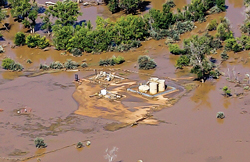|
In what some observers described as “epic flooding” and others termed “a 1,000-year flood,” northern Colorado was hit in September with record rainfall that swamped Boulder County and surrounding counties. The record weather event also prompted oil and gas producers to leap into action, to protect drilling and production sites, and limit damage from roaring floods. The term, “1,000-year,” actually refers to the fact that a rainfall event only has a 0.1% chance of occurring in any given year.
 |
As this Sept. 17 overhead photo shows, flash floods swamped wellsites, and in some cases, dislodged storage tanks in Weld County, Colorado, north/northeast of Boulder (photo credit: Associated Press).
|
|
Between Sept. 9 and Sept. 16, anywhere between 15 and 20 in. of rain fell in the region, with some towns and hamlets receiving virtually their entire, normal, annual rainfall within a week or less. In the city of Boulder, epicenter of this deluge, 17.15 in. fell in that time frame, pushing the 2013 total to a record 30.13 in., with more than three months left in the year. The previous record had been 29.93 in. in 1995. Boulder’s normal, annual rainfall is 20.68 in.
Effects from this onslaught were monumental—widespread, record flooding in both the Front Range foothills of the Rocky Mountains just west of Boulder, as well as in the city and into the Eastern Plains, plus homes and commercial buildings dislodged or swept away, scores of vehicles trapped and ruined, roads washed out everywhere, and thousands of people displaced. The official death toll at the end of September was eight. Authorities estimated that it would take many months for the area to recover.
Upstream operations affected. While the general public in northern Colorado struggled to deal with the aftereffects of the record rainfall and flooding, the E&P industry was experiencing its own problems. Scores of oil and gas field wells and facilities were damaged by the rushing waters heading downstream through flood plain areas. In some cases, tank batteries were toppled, and some tanks were washed away from their field sites. The affected production (and some drilling) operations were concentrated in the prolific Wattenberg play of the Niobrara shale region. According to the Colorado Oil & Gas Commission (COGC), close to 2,000 wells were shut-in at the height of the flooding, accounting for 12% of the state’s oil production. There are more than 51,000 wells, statewide, of which more than 45,000 were active in 2012, including more than 13,000 oil wells and 32,000-plus gas wells.
A number of operators were affected, including Anadarko Petroleum, EnCana and Noble Energy. Anadarko had about 600 of its 5,800 Wattenberg wells shut-in by the flooding, while Encana tallied about 400 wells affected. Noble said that about 760 of its wells were shut-in at the height of the problem. Independent PDC Energy had 130 of 2,380 wells shut-in. These firms, and others, jumped into action as the flooding continued after the rain, and sent out dozens of teams to assess the condition of wells, tank batteries and other field assets. For its part, Encana told Bloomberg News that in advance of the flooding, it had used a computer monitoring system to remotely shut down wells that were in the potential flood zones. That, along with other precautions, such as securing tanks and fencing off well sites, was credited for minimizing flood damage.
By Sept. 25, Noble had put 325 wells back online, with another 433 still shut-in. Similarly, Encana had brought back 320 of 397 wells. There were some problems with minor oil spills released, when field facilities were damaged. As of Sept. 30, COGC said that it was tracking 14 “notable spills” that totaled 1,042 bbl, or a bit more than three 300-bbl, field storage tanks. COGC was also tracking 12 produced water releases that added up to 413 bbl, as well as 16 additional sites that had evidence of a minor spill, such as a sheen. Predictably, environmental activists howled about the spills, citing them as evidence that oil and gas activity needs to be restricted or eliminated, and that fracing should be banned. The general news media behaved badly, as well, reporting spill amounts in gallons, rather than barrels, to make the numbers look worse, and using such superlatives as “catastrophic, spoiled, ruined and stained” to describe spill effects.
Two of the industry’s long-time congressional opponents, Reps. Jared Polis (Dem.-Colo.) and Peter DeFazio (Dem.-Ore.), in their typically rabid dog fashion, sent a letter on Sept. 27 to the U.S. House Natural Resources Committee, calling for a hearing on the spills. To his credit, Colorado Gov. John Hickenlooper, a Democrat and former geologist, tried to quiet down the shrill environmental cries. “Given the power of this flood, the fact that there hasn’t been that much leakage is incredible,” said Hickenlooper after a tour of flood-stricken areas.
One thing that was lost in the shuffle and not reported by the general media was the incredible generosity of the industry in the wake of the flooding. For instance, Anadarko contributed $500,000 in cash to local Colorado relief agencies, while also contributing far more than that in the form of food and water donations, as well as other supplies that included portable toilets. Similarly, Noble Energy donated $500,000 to agencies and said that it would match employee donations, up to $1,000 per person. Encana also donated $250,000 and said that it would match additional contributions from its employees. 
|





